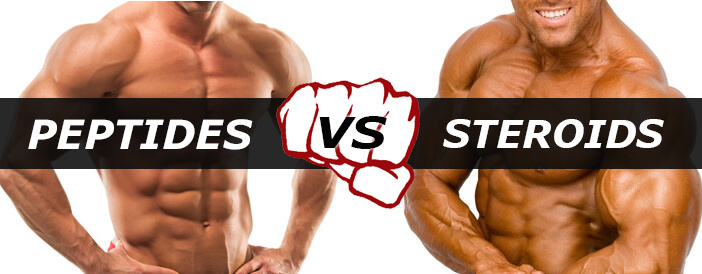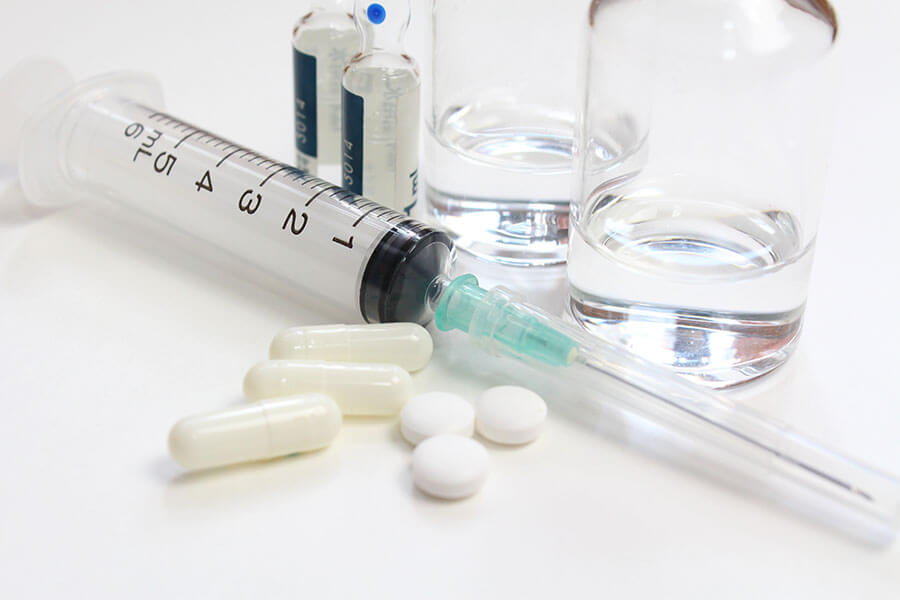
Peptides Vs Steroids
If we were going to sum up the difference between peptides and steroids in the simplest sense possible, we would merely state that peptides are simply sequences of amino acids, whereas steroids are synthesized steroid hormones.
The Difference Between Peptide and Steroids
At the base of it all, this is precisely where the difference between them lies. If we were to stop there however, you’d still have very little understanding of precisely what this difference means in terms of the way they actually work.
Luckily, you already have one half of the equation in check through understanding the mechanism of action exerted by peptides – their entire functionality revolves around the amino acid codes they contain, which in turn leads to either a neurological or cellular response (or both) occurring within the body.

Steroid hormones
Steroid hormones on the other hand work in a slightly different fashion.
 There are actually several such hormones within the body, but of primary concern in regards to anabolic steroids is the steroid / sex hormone testosterone.
There are actually several such hormones within the body, but of primary concern in regards to anabolic steroids is the steroid / sex hormone testosterone.
Anabolic steroids are all derived from testosterone, including the testosterone derivatives Dihydrotestosterone (DHT) and 19-nor compounds. Others are directly based on testosterone itself as opposed to one of its derivatives.
Testosterone is a vital component for the development of male characteristics (or androgenic characteristics) in both males and females alike (though females have a much lower testosterone level.)
This includes the growth and repair of lean muscle tissue.
This is where the differences between steroids and peptides really begin to shine through – their mechanisms of action are rather stark in their contrast to one another.
Whilst growth hormone secretagogues can improve anabolic capacity through the elevation of IGF-1, and subsequently MGF levels within the body – anabolic steroids have a much more “hands on” approach to their cellular manipulation.
The latter directly intervenes with the processes relevant to muscle growth and recovery, and whilst enhanced levels of testosterone do in fact lead to the elevated release of growth hormone and IGF-1 in their own right (thus instigating “passive” anabolism); it’s the manner in which they “aggressively” exert their effects that makes a considerable difference overall.
This also proves to be their downfall in some people’s eyes, as such an “aggressive” mechanism of action does come with some cost attached in the form of elevated side effect risk when compared to peptides.
Not all AAS types are “potent” of course, but even the mildest are generally accepted as being capable of presenting a higher risk of adverse issues when compared to secretagogues and arguably growth hormone too – this is true of both oral and injectable varieties.
Steroid hormones
Steroid hormones on the other hand work in a slightly different fashion.
 There are actually several such hormones within the body, but of primary concern in regards to anabolic steroids is the steroid / sex hormone testosterone.
There are actually several such hormones within the body, but of primary concern in regards to anabolic steroids is the steroid / sex hormone testosterone.
Anabolic steroids are all derived from testosterone, including the testosterone derivatives Dihydrotestosterone (DHT) and 19-nor compounds. Others are directly based on testosterone itself as opposed to one of its derivatives.
Testosterone is a vital component for the development of male characteristics (or androgenic characteristics) in both males and females alike (though females have a much lower testosterone level.)
This includes the growth and repair of lean muscle tissue.
This is where the differences between steroids and peptides really begin to shine through – their mechanisms of action are rather stark in their contrast to one another.
Whilst growth hormone secretagogues can improve anabolic capacity through the elevation of IGF-1, and subsequently MGF levels within the body – anabolic steroids have a much more “hands on” approach to their cellular manipulation.
The latter directly intervenes with the processes relevant to muscle growth and recovery, and whilst enhanced levels of testosterone do in fact lead to the elevated release of growth hormone and IGF-1 in their own right (thus instigating “passive” anabolism); it’s the manner in which they “aggressively” exert their effects that makes a considerable difference overall.
This also proves to be their downfall in some people’s eyes, as such an “aggressive” mechanism of action does come with some cost attached in the form of elevated side effect risk when compared to peptides.
Not all AAS types are “potent” of course, but even the mildest are generally accepted as being capable of presenting a higher risk of adverse issues when compared to secretagogues and arguably growth hormone too – this is true of both oral and injectable varieties.
Some Side Effects
Some of the side effects that are considered to be “exclusive” (more emphasis on this later) to anabolic steroid use include:
- Liver hepatotoxicity (with oral steroid types)
- Violent mood swings
- Testosterone synthesis suppression
- Adverse skin conditions
Elements like liver hepatotoxicity and testosterone synthesis suppression can be controlled relatively easily via the integration of the relevant supplementary material and an effective post cycle phase.The other stated issues have more to do with the genetics / internal dynamics of the individual using them as opposed to the direct chemistry of the products.


Now that we have stated the “exclusive” negatives when utilising anabolic steroids, we’ll now focus on the positives. The following benefits are almost exclusively associated with steroid use:
- Enhanced muscular dryness
- Enhanced vascularity
- Enhanced (direct) lipolysis / fat burning
- Dramatically enhanced (direct) strength
- Enhanced muscular endurance as a result of enhanced oxygen uptake / red blood cell production
You might experience some of these effects to varying degrees when using growth hormone secretagogues, but whether or not they manifest is going to be primarily down to your nutritional and training habits rather than the product you’re using. On balance, certain AAS types can directly enhance these areas in their own right independently of training and nutrition habits; both compounds require effective nutrition and training habits to achieve beneficial results however.
It’s worth noting that not all of the above outlined benefits are likely to be achieved by taking one steroid type alone – certain steroids “specialise” in the manifestation of either one or several of the above properties, hence why “stacks” are so prevalent amongst the anabolic community.
Some of the common traits of both anabolic steroids and peptides alike are:
- They are both capable of improving anabolism
- They can both increase the recovery rate of the individual
- They can both arguably provide anti aging effects
- They can both increase strength (though they achieve this end result via different mechanisms of action)
- They can both improve a sense of internal wellbeing / energy
- They can both mutually boost one another’s respective effects
Through reading this section thus far, you should have a better understanding of the unique traits on offer with these product types.
Where many people go wrong is through seeking to find a “best” option when comparing peptides to steroids; the two simply aren’t directly comparable and this is a little like comparing a helicopter to a plane. Both have their individual merits.
Some believe that using peptides only is the key to safe and effective physical development, whereas others believe that growth hormone / gh secretagogues are unnecessary and AAS types are all they need to achieve their physical goals.
In truth; both item types are incredibly effective when used properly, and they are arguably at their best when combined. The relatively low risk nature of gh secretagogues means that they can weave seamlessly into steroid cycles as a means of further boosting the results on offer without negatively affecting the steroids present in the body.
It’s ultimately about which option you believe is going to suit your needs best, but keep in mind that neither choice is “wrong” – both compounds are part of very different worlds.


